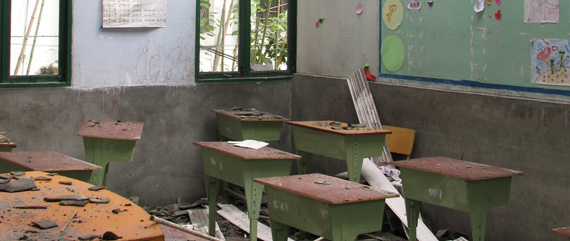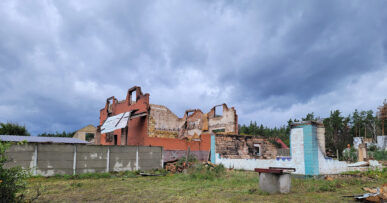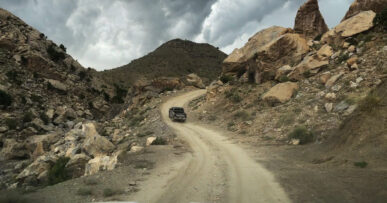- Sichuan China 2008 Earthquake Journal, Part 1
- Sichuan China 2008 Earthquake Journal, Part 2
- Sichuan China 2008 Earthquake Journal, Part 3
SICHUAN, China–Following the May 12, 2008 M8 Sichuan Earthquake, Miyamoto International and Global Risk Miyamoto immediately dispatched a team to the affected region. Our reconnaissance team was composed of Chris Heaton, Global Risk Miyamoto, Rocky Ng, engineer from China Rail Way, Tenth Group, Third Engineering Company, and the author, Kit Miyamoto of Miyamoto International and Global Risk Miyamoto.
At 10:30 a.m. My team and I are joined by a TV news crew from NHK (Japanese Broadcast Corporation) who worked with us and reported on our observations of the damage and the reasons for it.
Chengdu is the capital of Sichuan province with a population of over 10 million. It is a modern city. NHK meets us at the Intercontinental Hotel in Chengdu. We depart for Juyuan Township, Dujiangyan City, where a middle school collapsed and buried 700 kids. They insist that we wear masks since the smell of death is overwhelming.
At 11:49 a.m. we’re driving on Highway 213 which runs through beautiful woodlands to get to Juyuan. The population here is well over 50,000. This town is 60 km from Chengdu and about 50 km from the fault rupture. We park our van and walk through a devastated retail and residential street to reach the Juyuan Middle School.
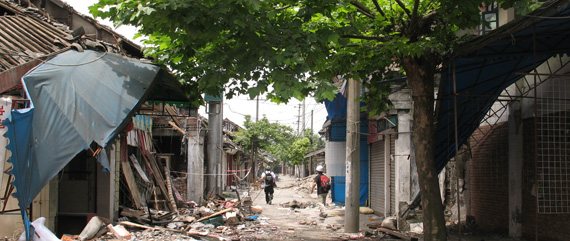
I witness a large mound of rubble, the remains of the school that once housed 1000 students. 700 kids died here and 20 are still missing. The collapsed building is constructed of non-ductile cast-in-place concrete columns and beams, and precast concrete floor planks. Infilled walls are unreinforced masonry. Juyuan Middle School was built in 1996 which is relatively modern. However, the non-ductile detailing of concrete elements and unreinforced masonry turned out to be the killers. This type of construction has always performed very poorly in strong earthquakes; it has been outlawed in California, for example, since the mid 1970s.
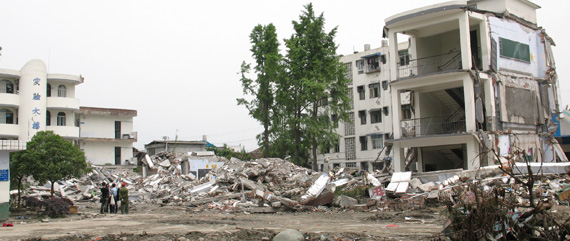
We enter a damaged, but not collapsed, school building right next to the rubble. The damage is slight. This may be due to better orientation (for the earthquake forces to which it was subjected) of the building and better construction quality. A local man tells us that the collapsed building had a one story addition on top of the existing 2 levels. This may have contributed to this tragedy. Next to the rubble is a large soccer field covered with white powder. We were told that 700 dead middle school children laid here a few days ago. The white powder is for disinfection…
We arrive at the Juyuan elementary school at 1:30 p.m. This is a 4-story concrete building that appears to be of similar construction to Juyuan Middle School. But the difference in damage is phenomenal. There are few shear (diagonal) cracks in the shear walls and minor pounding damage between buildings, but no collapse! This building was built in 2007 – brand new! The lack of major damage tells us that the latest Chinese construction practice, if practiced widely, may be much better. Unfortunately, the danger associated with older non-ductile concrete structures is not China’s problem alone – It is a worldwide problem. We must address these buildings in any seismic hazard area to avoid future tragedies.
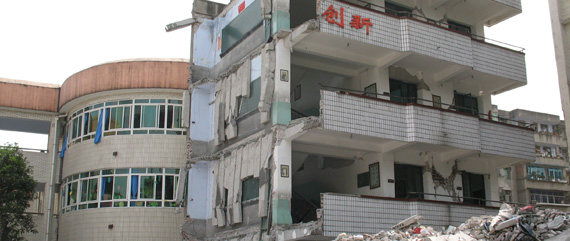
The principal of the school asks us to evaluate the building for safe entry. Apparently the town has not established a building inspection and safe entry tagging system for buildings. I use a standard California rapid inspection technique to assess the structure and recommend repairs needed prior to re-occupancy. It would really help if they had a similar inspection regime as California and Japan, where we have thousands of trained volunteer engineers to inspect and tag buildings for safety – Red for no entry, Yellow for limited entry, and Green for safe entry.
At 2:15 p.m., about a mile or so from the collapsed middle school, I see an office complex under construction. It is almost completed and the construction type is similar to the elementary school. Damage was limited to non-structural components. We run inside the building. The NHK producer and cameraman run after us. These guys are dedicated! We sometimes run to minimize the time inside of the damaged buildings. In this building, I see a lot of suspended ceiling panel failures. There is no wire bracing… of course. This simple bracing system would have minimized the damage and the business interruption to this building.
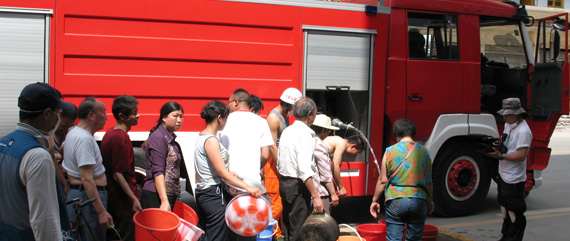
We enter the City of Xing Fu at 3:30 p.m. With a population of over 300,000. The downtown is approximately 50 km from the epicenter. We park our van and walk through the downtown streets. My first impression is that damage in Xing Fu is limited.
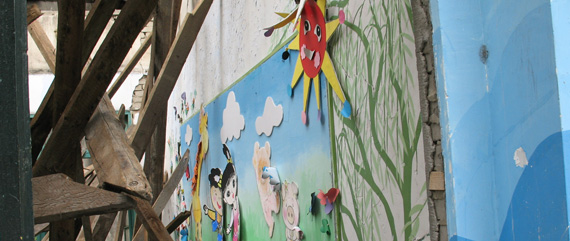
We pass a little tunnel-like gate to enter the school grounds… I could not believe my eyes – Total collapse of a 4 story school building. I meet a young mother who is carrying a picture of a little girl. She tells me that this was her 7-year old daughter who died under the rubble. I have 3 young kids also. I think about them when I see the picture of a little girl… The construction type and vintage is the same as what we saw this morning in Juyuan. This can be avoided with proper earthquake strengthening and rehabilitation.
At 4:30 p.m. we try to drive to the epicenter by continuing on Highway 213, but the road is closed by the police just outside of town. The danger of land slides make it impossible to go further today.
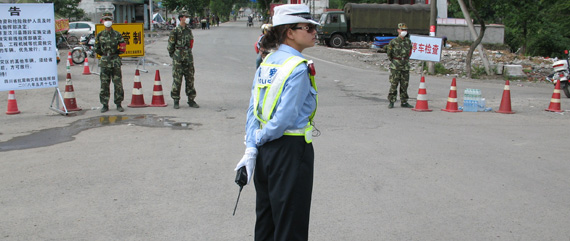
Fifteen minutes later we return to Xing Fu to continue our survey. On an eerily, quiet, abandoned street, we come across a half collapsed, 5-story concrete apartment building. The corner of the structure totally collapsed into the street. It appears that the soft story columns failed and lost their capacity to support the structure above. Interestingly, immediately next door is an almost identical building with minor damage. Construction quality and possibly some vital structural details are the likely difference here.
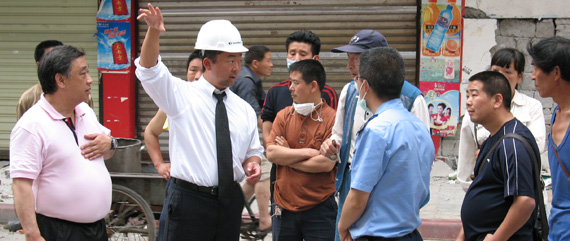
On the way back to our van, we are surrounded by the local folks who beg us to inspect their mid-rise apartment buildings for safety. We do the best we can to help…but the numbers are overwhelming.
For the last stop at shortly after 6 p.m., we visit a hospital that collapsed on top of 200 patients. It is a 1980s concrete building. I must say that it is hard not to be depressed by the sight of so much death and destruction all around. I hope the lessons from this earthquake will be acknowledged by governments and contractors around the world, so we can save lives.
We will head closer to the epicenter tomorrow…
